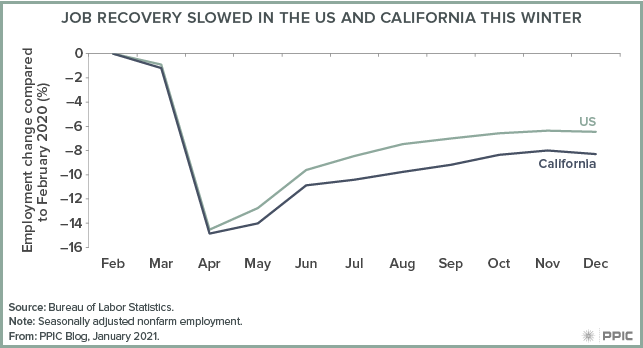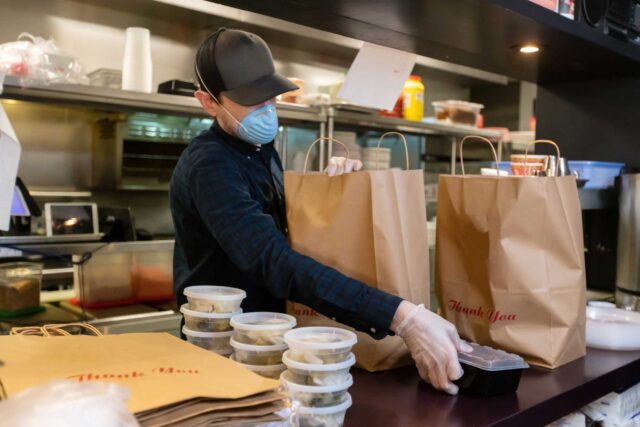With COVID-19 surging this winter, job growth is once again on the skids. Until we emerge from the public health crisis, economic activity will continue to fluctuate, due to mandated stay-at-home orders, business closures, and individual fears about the virus. Given the uncertainty, what can we expect from the California labor market in 2021?
Job recovery will be limited until COVID is contained. California and the US have been trying to recover from the massive employment loss of spring 2020—California lost 15%, or 2.6 million, of its jobs between February and April. In December, the US and California suffered net job losses (140,000 and 52,000, respectively) for the first time since April. California’s rate of decline was slightly worse than the US decline—a continuation of the pattern throughout 2020.

Recovery will become more difficult the longer the recession persists. Long spells of unemployment are especially challenging for workers; skills and job networks erode over time, and long-term unemployment can be seen by employers as a negative sign. As of mid-November, an estimated 22% of California’s workforce qualified for unemployment benefits. Some sectors may shift as a result of pandemic, while others may not fully recover. The service sector is particularly important to watch: in leisure and hospitality, jobs were down 30% between February and December (by about 618,900 jobs), compared to an overall statewide decline of 8%.
Labor force participation will be critical to watch. With an aging population, California’s economic vitality depends on the employment of all who are able to work. As of December, roughly 555,000 fewer Californians were in the labor force compared to February. Just over 60% of the population was working or looking for work—significantly below the pre-pandemic rate (62.6%), and the lowest labor force participation rate in at least four decades. Parents—especially mothers—who left the workforce to care for children or dependents during the pandemic are a key group to watch.
Recovery depends on getting diverse groups back to work. Top-line economic indicators such as the state’s unemployment and job growth rates are not designed to reflect inequities across California’s diverse demographic groups. Low-income families and workers of color have been hit especially hard by this recession, as long-standing economic inequality has been exacerbated in 2020 and early 2021. This year, more than ever, it is critical to look behind the top-line indicators to gauge whether low-income families and workers of color are recovering.
Needs during the recovery will vary across regions. Past recessions typically hit hardest in inland California, but some of the sectors most impacted by this recession—especially leisure and hospitality—are heavily concentrated elsewhere in the state. For most of 2020, unemployment in Los Angeles County was much higher than in the Inland Empire or Central Valley. In December, however, increases in unemployment across the state reduced some of these disparities: LA’s rate was 10.7%, compared to 9.1% in Riverside and 10.4% in Fresno, for example. Regions in which large shares of the workforce can telework may be faring relatively well overall—in San Francisco, 6.4% were unemployed in December. But the sectors that support office work in these regions (including retail and restaurants) will continue to struggle.
Policy efforts to ensure an equitable labor market recovery will be hamstrung until the COVID-19 public health crisis abates. Out-of-work Californians need ongoing support—including stimulus payments, unemployment insurance, and safety net benefits—to get through a difficult period of curtailed opportunity. Support for businesses is also critical to ensuring a quick resumption of economic activity—and hiring.
Californians who have been out of work and/or out of the labor force will be better able to take advantage of new opportunities during the recovery if they have access to reliable, affordable child care, as well as training for high-quality jobs. State and local policymakers should prioritize sectors, regions, and communities in most need to ensure a more equitable recovery and avoid the historical pattern of widening economic inequality. The federal stimulus measure passed in late December, along with California’s strong budget situation, should allow the state to lay the groundwork for such a recovery in 2021.






